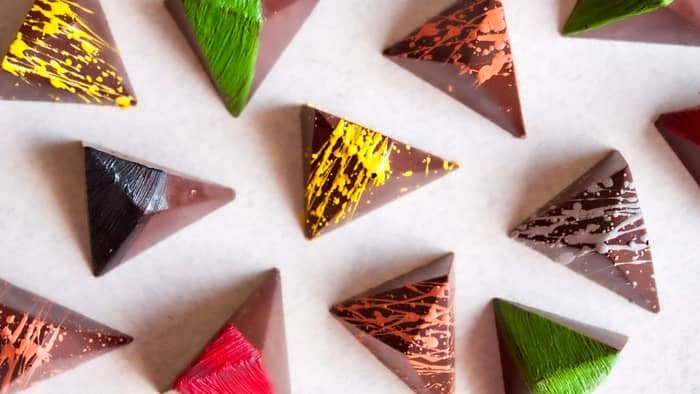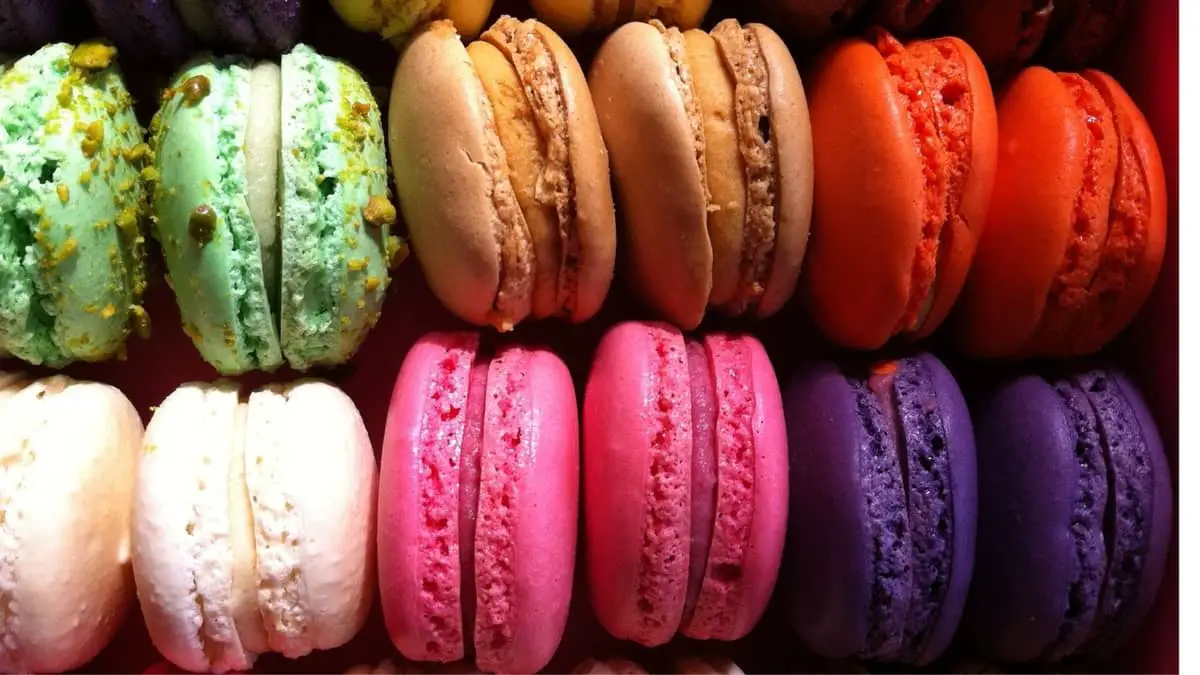Last Updated on February 4, 2023
Today, we’re going to be answering the question: is gel food coloring oil based? Food coloring is a great way to brighten up your favorite desserts. Using oil-based food coloring can be one of the best ways to color food, depending on what you are making. It can create beautiful, vibrant creations that will stand out.
Whether for a birthday party or graduation, having beautifully colored desserts can make the day even more special. Oil-based food coloring is great to use for many different foods. They are commonly used among many professional bakers to color different desserts.
Is Gel Food Coloring Oil Based: Using Oil-Based Food Coloring
Oil-based food coloring is specially formulated to bind to oil-based products. It is meant to be used with any food where adding water would affect the mixture. It is specifically meant to be used with chocolate, candy melts, icing, and any fat or oil-based products.
With chocolate, you should never use regular food coloring as it will cause the chocolate to seize up. This will then ruin your chocolate, making it no longer presentable.
Oil-based food coloring is specifically made for binding coatings on candy melts and chocolate. Chocolate and candy melts are sensitive to water, which is why traditional food coloring does not work for them.
Oil-Based Food Coloring for Chocolate
No matter what type of chocolate you are working with, whether it is compound chocolate or genuine couverture chocolate, oil-based food coloring is the way to go. Using oil-based food coloring will ensure smooth, consistent coloring throughout the chocolate.
If you try to use water-based food coloring it will not properly mix into the chocolate, which will lead to it seizing. Oil-based food coloring provides bright, vibrant colors within your chocolate. There are many different colors available that you can use to color your chocolate, or other fat or oil-based foods.
Other Types of Food Coloring
There are several other types of food coloring available on the market. If you bake regularly, you will want to know the differences between them all so you know when to use what kind. Not all food colorings are created the same and not all of them can be used interchangeably.
Liquid
Liquid food coloring is the most popular type to use and consists of synthetic coloring and a water base. It is ideal for achieving pastel colors but is not the best option for choosing darker, brighter colors.
Liquid food coloring is common for coloring cookies, cakes, doughs, and frostings. It comes in small squeeze bottles and is easy to use.
Chocolate Coloring Oil-Based Food Dye for Chocolate Candy Melts
Gel
Gel food coloring is much thicker than liquid food coloring. It creates more vibrant, darker colors, as less goes a long way. The color will deepen as it sits, so you often only need a few drops.
Gel food coloring is ideal for foods where you don’t want to add excess moisture, such as macarons. It is also great to achieve vibrant colors in cakes, frosting, and dough.
Liquid-Gel
Liquid gel is water-based but it also contains corn syrup and glycerine to make it thicker than traditional liquid food coloring. It is easier to use than gel food coloring and will provide deeper colors than liquid food coloring.
Liquid gel is ideal for fondant, frosting, and cakes. It is a versatile food coloring that can be used for many different foods, except chocolate.
Powder
Powder food coloring does not contain any liquid. It is great for use on foods sensitive to additional liquid, such as macarons or chocolate.
It does not mix well with water so instead, it should be mixed with a small amount of alcohol. You can also use a food-grade paintbrush and apply it directly to food as decoration. It does not mix well in batters.
Natural
Natural food coloring is a liquid food coloring that uses only natural ingredients to make the colors. It uses ingredients such as beets, turmeric, and even spinach to make colors.
Natural food coloring is a great alternative to traditional food colorings if you are wanting to take a natural approach. However, it does not create very vibrant colors and you need to use several drops.
Airbrush
Though not as common, airbrush food coloring is used in an airbrush to decorate foods. It is great for use as decorations on cakes and even chocolate.
Is Gel Food Coloring Oil Based?
When it comes to gel food colorings, they are most often made from glycerin and ingredients such as corn syrup. Because of this, they are typically oil-based, rather than water-based. They usually are much more vibrant in color, and you’ll need to lose less because of their level of saturation.
Can You Use Gel Food Coloring in Chocolate?
Yes. Gel and powder food coloring are the only food colorings recommended when it comes to coloring chocolate. It’s best to buy an oil-based gel food coloring that has been designed specifically for coloring chocolate and candy melts. Leading brands like Wilton will offer many options.
It’s important not to use any water-based coloring on your chocolate, as this will cause it to seize. This includes food colorings such as liquid food coloring and icing coloring.
To color candy melts/chocolate, all you need to do is dip a toothpick or skewer into your food coloring and then mix it into your melted candy. Keep adding small amounts until you’re satisfied with the color.
Is Wilton Icing Color Oil Based?
Yes, the icing color from Wilton is gel-based. This type of oil is great if you’re not wanting to water down your baked goods. This type of food coloring is best for coloring ingredients such as icing, frosting, fondant, and batter.
A 1oz jar of this coloring costs anywhere from $2.50-$4 and comes in a variety of colors. It’s worth mentioning that these products are made in a place that processes a range of allergens, such as wheat, soy, shellfish, milk, fish, shellfish, peanuts, and tree nuts – so may not be suitable for all.
Gel Food Coloring vs Liquid vs Powder
When it comes to the types of food coloring you can use, there are three main options: gel, liquid, and powder. The less liquid that the food coloring contains, the more vibrant the coloring will usually be. This is why gel and powder colorings are used to create bold, bright colors. Whereas liquid food coloring is better for pastel and light colors.
- Liquid food coloring is best for light and pastel colors. You’ll usually need to use a few drops to color whatever it is that you’re coloring. This type of coloring is best for the following products: frosting, cake, and cookies.
- Gel food coloring is best for bright colors. As the color is quite vibrant, you’ll typically only need a tiny amount on the end of a toothpick. Only add small amounts and swirl into your baking, until you’re happy with the color. This type of coloring is best for the following products: large batches of cake batter or frosting etc.
- Powder food coloring is the boldest and deepest level of coloring. You typically only need a small amount, much like gel food coloring. This type of coloring is best for the following products: chocolate and candy.
Best Food Coloring for Baking
The best type of food coloring all comes down to what you’re needing to color. Certain types of food coloring are best for coloring certain types of foods. Let’s take a closer look.
- Liquid food coloring is great for coloring icing, dough, and batter. And is best for lighter, pastel colors.
- Gel food coloring is great for coloring large volumes of frosting and icing. And is best for vibrant colors.
- Powder food coloring is great for coloring chocolate and meringue. And is best for dark, bold colors.
- Natural food coloring is great for coloring desserts that aren’t baked. And is best for subtle colors.
- Oil-based food coloring is great for coloring hard candy and chocolate. And is best for vibrant and dark colors.
- Airbrush food coloring is great for coloring fondant and royal icing. And is best for vibrant and dark colors.
Creating Beautifully Colored Chocolate
I hope this post has helped to answer the question: is gel food coloring oil based? Though there are a few types of food color that work to color chocolate, oil-based food colorings are the best way to go. They create bright, beautiful colors while keeping the consistency of the chocolate smooth. You want to avoid using traditional liquid food coloring with chocolate as it will not mix well.

Oil-based food colorings are ideal to use on any food where adding water could cause problems. They are also great to use in candy melts and frostings as well. Though you can buy oil-based food coloring, you can also make your own by combining vegetable oil and gel food coloring.
Do you have any questions regarding oil-based food coloring? If so, please ask any questions regarding using oil-based food coloring in the comment section down below.
FAQs
How to Make Oil-Based Food Coloring?
You can easily make your own oil-based food coloring at home. To do so, you will need vegetable oil and gel food coloring.
Take 1/2 teaspoon of vegetable oil and mix it together with two drops of gel food coloring. Repeat with every color and repeat the process as needed. You can then use it to color chocolate or candy melts.
What is Oil-Based Food Coloring?
Oil-based food coloring is designed to bind to oil-based products such as chocolate and candy melts. It generally contains glycerol, colors and lecithin. It will create an even, smooth, vibrant coloring in chocolate that will stand out and will not cause the chocolate to seize.
Where to Buy Oil-Based Food Coloring?
Some grocery stores may sell oil-based food coloring, but they can be hard to find at some grocery stores. Many baking and craft stores will sell it. You can also buy oil-based food coloring online as well and there are many different brands available.

Ever since she was a young girl, Anna has been a lover of desserts. As an adult, she enjoys
baking a variety of desserts from cakes, cookies, brownies, bread, and more from scratch. She
enjoys sharing her passion for baking with others who also have a sweet tooth. From properly
measuring ingredients to making sure they are the correct temperature, Anna knows the
importance small details can make in baking. She wants to share her experience with others in
hopes they can make the most delicious baked goods. When she’s not busy blogging, Anna
enjoys trying new recipes in the kitchen.


